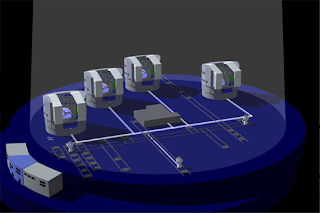Paper Moon Luna is the name of the satellite of the Earth, and is approximately 1 / 4 the diameter of our planet. It is the fourth satellite in the Solar System in diameter.
As is smaller and is made of materials less dense than Earth, its gravity is only 1 / 6 than ours. Has 1 / 81 the mass of our planet.
His "atmosphere" and surface. has no atmosphere and its surface is heavily cratered. It is estimated that the visible side is more than 30 thousand craters over 100 meters in diameter. Perhaps the Earth was the same number of craters, but was erased by erosion. Therefore
meteorites generally burned in the atmosphere on the moon go directly to the surface, no matter how large they are. Many millions of years This process makes the lunar soil is so disjointed, it's like a powder called "regolith."
 |
| From Apollo 16, you can clearly see the regolith. |
can see dark areas on its surface, called seas, although it is known that the Moon has no liquid water. The mare
are formed by dry lava flowed for many thousands of millions of years ago when asteroids collided with its surface. The dark side has almost no seas, and there is still a full explanation of it is so.
Their movements Circulated to our planet every 27.5 days, and complete the period of its phases at 29.5 days; This is the reason that our months are 30 days.
has named several periods, namely:
synodic revolution: is the length of time required for the moon again have a similar position to the sun and Earth. Its duration is 29 d 12 h 44 min. 2.78 s. Also called lunation or lunar month.
Sidereal Revolution: is the length of time it takes the Moon to return to a similar position with respect to the stars. Its duration is 27 d 7 h 43 min 11.5 sec
tropic Revolution: is the time it takes for the moon again have the same celestial longitude. Its duration is 27 d 7 h 43 min 4.7 sec
draconítica Revolution: is the time it takes the Moon to pass two consecutive times for the ascending node. Its duration is 27 d, 5 h 5 min 36 s.
anomalistic revolution: is the interval time between 2 consecutive steps of the Moon perigee. Its duration is 27 d 13 h 18 min 33 sec
As is so close produces tides on our planet, both in the water and on atmosphere. Is primarily responsible, plus the sun, ocean tides on our planet.
 |
| visible faces (left) and invisible (right) of the Moon, photographed by the Clementine spacecraft. |
currently has a low volcanic activity, but may still be seen LTP (transient lunar phenomena) that are brightening in some areas, caused by exhaust gases.
The Other Side of the Moon was unknown until the Russian spacecraft Lunik III took pictures in 1959. Seven missions visited the moon, Apollo Series, though only six arrived. Occurred between 1969 and 1972, carrying 12 men to the surface. For proof that they actually arrived, you can see here
.
The librations Another interesting issue is that in general, we see only one side of the moon. In fact, the moon appears "pitching" a little side to side and up and down. This motion is called libration, and causes us to see 59% of the lunar surface, more than 50% we should see if this effect did not exist.
There are several causes for the librations. The most significant is that the moon rotates on a consistent basis, and its orbit is not a circle. This is called optical libration
, it is caused by point of view, and is not a real change in the movement of the moon.
addition, the Earth rotates, the angle at which the observers see the moon changes slightly. This effect is less than one degree, and is not as important as the optical libration. This is called diurnal libration
.
Finally, there is a real, but minor, movements of the moon. Is a few arcminutes. It is called the Physical Libration
.
has been discovered by space ships in orbit around existing mass concentrations, called "
Mascons ." Are associated with higher density areas a few miles depth. The
moon phases correspond to different times of illumination from the Sun
The origin and future There several theories, the most accepted origin is that when I first had formed the earth, even fluid, a Mars-sized object hit her, so she took mass to our planet, which is rotating and then formed our Moon. Thus the Earth long ago had a ring.
 |
| Court of the moon, developed using physical models and measuring moonquakes. |
also explains why the moon appears to have a hundred million years younger than the Solar System and Earth.
Apparently according to the latest space missions, containing solid water in the area of \u200b\u200bthe poles, in the depth of the craters where their location, never gives sunlight
Our satellite is moving away slowly, (about 3 cm per year), so in a few billion years we will lose. Long before we leave to see total solar eclipses
, but if you continue to see much longer
lunar eclipses.











































